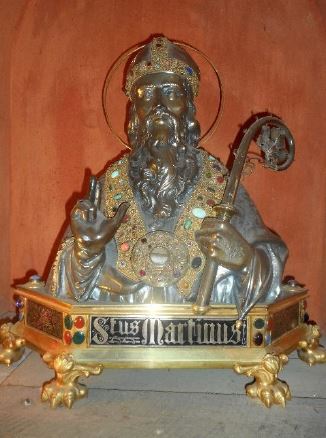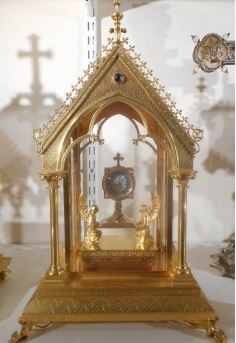Fondée par saint Martin de Tours en 361 à une dizaine de kilomètres au sud de Poitiers, à l’emplacement d’une villa romaine en ruine reçue de l’évêque de Poitiers saint Hilaire, l’abbaye de Ligugé est tout d’abord un ermitage mais le nombre de disciple qui l’y rejoigne le force à fonder un monastère. Il le quitte en 370 lorsqu’il est nommé évêque de Tours. Au Ve siècle, comme la région est occupée par les Wisigoths, le monastère est abandonné. Il reprend une activité après la victoire de Clovis à la bataille de Vouillé. En 591, Grégoire de Tours vient en pèlerinage à Ligugé. Très actif pendant la période carolingienne, sans doute ruiné pendant les invasions normandes, il est rétabli vers 1003 par Aumode de Poitou, l’épouse du comte Guillaume V le Grand , qui y installe quelques moines venu de l’abbaye de Maillezais, dont elle devient un prieuré dépendant. En 1307, le monastère est la résidence du pape Clément V durant son séjour à Poitiers. Détruit en 1359 par les troupes du roi de France, pour empêcher les Anglais, qui occupaient les lieux depuis 1346, d’en faire un point d’appui pour prendre Poitiers, le monastère est reconstruit partiellement par les moines de Maillezais. En 1501, il passe sous le régime de la commande et en 1504, une importante restauration est entreprise par Geoffroy d’Estissac. Mais le monastère est de nouveau fortement endommagé durant les guerres de Religion, il subit en particulier un incendie durant le siège de Poitiers en 1569. Au XVIIe et au XVIIIe siècle, il est confié aux jésuites qui engagent d’importants travaux de restauration, mais les jésuites sont expulsés de France en 1762. Ligugé est saisi comme bien national durant la Révolution française, et est racheté par le minotier Véron. Mis en vente en 1852, il est racheté par Mgr Louis-Edouard Pie, évêque de Poitiers, et dom Guéranger, venu de l’abbaye de Solesmes, s’y installe avec quatre religieux afin d’y restaurer la vie monastique. Elle retrouve son titre d’abbatiale en 1856 par Pie IX, et dom Léon Bastide devient le premier abbé en 1856. En 1901, suite au lois anticongréganistes, la communauté part à Chevetogne, en Belgique, et peuvent y revenir en 1923. Une église claustrale est établie en 1929 car l’église abbatiale était entretemps devenue paroissiale. Durant la Seconde Guerre mondiale, les communs sont réquisitionnés par les nazis, mais Ligugé devient un lieu de résistance, voyant le père Lambert, membre du réseau Renard, décapité au camp de Wolfenbüttel le 3 décembre 1943. Un atelier d’émaillage est créé en 1945. Des fouilles archéologiques sont réalisées dans les années 1950-1960.
L’abbaye de Ligugé conserve deux reliquaires de saint Martin. Le premier est un buste-reliquaire de saint Martin qui se trouve dans une niche du cloître. Il a été réalisé par les frères Devroye, orfèvres à Bruxelles, suivant les dessins du père Brasseur, moine de l’abbaye de Ligugé. C’est un reliquaire en argent massif, repoussé au marteau puis ciselé. Il mesure 56 cm de haut, 52 cm de long à la base, il pèse 15,700 kg et contient 143 pierreries (socle compris). Saint Martin figure en évêque nimbé d’un mince filet d’argent doré, marquant sa sainteté. Le deuxième se trouve dans la chapelle de l’abbaye. C’est un reliquaire particulier puisqu’il est à la fois chapelle-reliquaire et reliquaire-monstrance.
Founded by Saint Martin of Tours in 361, some ten kilometres south of Poitiers, on the site of a ruined Roman villa given to him by Saint Hilaire, bishop of Poitiers, the abbey of Ligugé was initially a hermitage, but the number of disciples who joined him there forced him to found a monastery. He left it in 370 when he was appointed Bishop of Tours. In the 5th century, as the region was occupied by the Visigoths, the monastery was abandoned. It resumed activity after Clovis’ victory at the Battle of Vouillé. In 591, Gregory of Tours made a pilgrimage to Ligugé. Very active during the Carolingian period, but probably ruined during the Norman invasions, it was re-established around 1003 by Aumode de Poitou, wife of Count William V the Great, who installed a number of monks from Maillezais Abbey, of which it became a dependent priory. In 1307, the monastery became the residence of Pope Clement V during his stay in Poitiers. Destroyed in 1359 by the troops of the King of France to prevent the English, who had occupied the site since 1346, from using it as a stronghold to take Poitiers, the monastery was partially rebuilt by the monks of Maillezais. In 1501, the monastery was placed under commission and in 1504, a major restoration was undertaken by Geoffroy d’Estissac. However, the monastery was again severely damaged during the Wars of Religion, and in particular suffered a fire during the siege of Poitiers in 1569.In the 17th and 18th centuries, it was entrusted to the Jesuits, who undertook major restoration work, but the Jesuits were expelled from France in 1762.Ligugé was seized as national property during the French Revolution, and was bought by the miller Véron.Put up for sale in 1852, it was bought by Mgr Louis-Edouard Pie, Bishop of Poitiers, and Dom Guéranger, who had come from Solesmes Abbey, settled there with four monks to restore monastic life.The abbey’s title was restored in 1856 by Pius IX, and Dom Léon Bastide became the first abbot in 1856.In 1901, following the anti-Congregation laws, the community moved to Chevetogne, Belgium, and was able to return there in 1923.A cloister church was established in 1929, as the abbey church had in the meantime become a parish church. During the Second World War, the outbuildings were requisitioned by the Nazis, but Ligugé became a place of resistance, seeing Father Lambert, a member of the Renard network, beheaded in the Wolfenbüttel camp on 3 December 1943. An enamelling workshop was set up in 1945. Archaeological excavations were carried out in the 1950s and 1960s.
Ligugé Abbey has two reliquaries of Saint Martin. The first is a bust-reliquary of Saint Martin, which is in a niche in the cloister. It was made by the Devroye brothers, goldsmiths in Brussels, to designs by Father Brasseur, a monk at Ligugé Abbey. It is a solid silver reliquary, hammered and chased. It is 56 cm high, 52 cm long at the base, weighs 15.700 kg and contains 143 jewels (including the base). Saint Martin is depicted as a bishop, surrounded by a thin band of gilded silver to mark his holiness. The second is in the abbey chapel. It is a special reliquary in that it is both a chapel-reliquary and a reliquary-monstrance.


